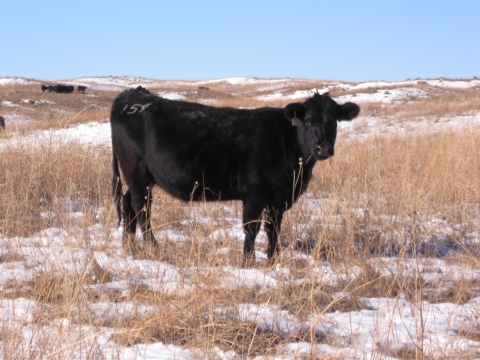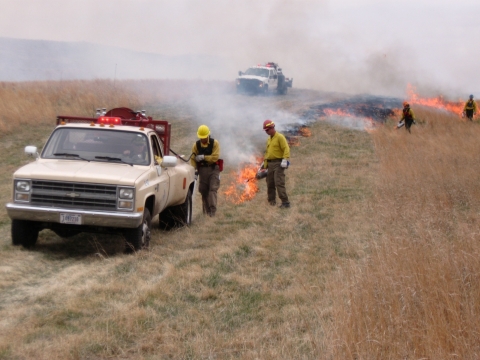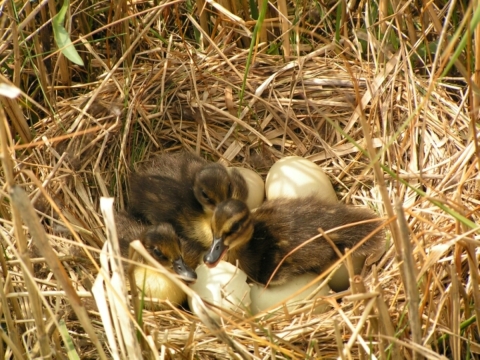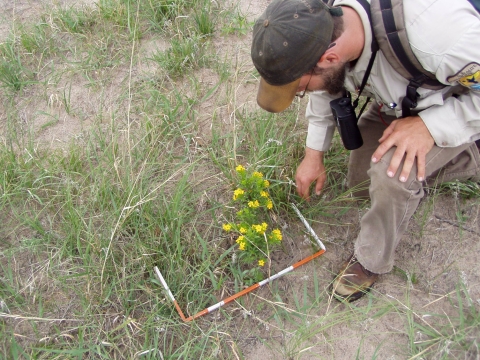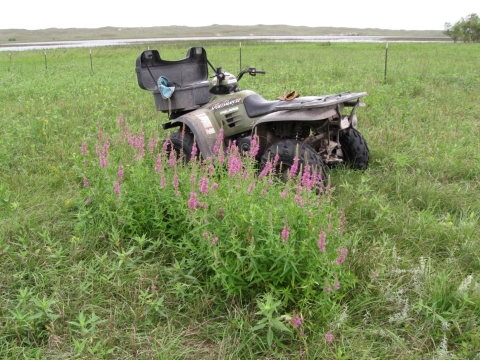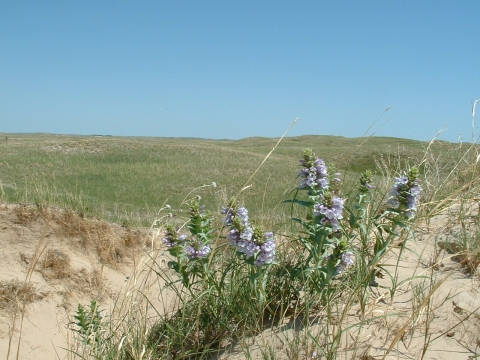What We Do
Refuges deploy a host of scientifically sound management tools to address biological challenges. These tools span active water management to wilderness character monitoring, all aimed at ensuring a balanced conservation approach to benefit both wildlife and people. At Valentine National Wildlife Refuge, our conservation toolbox includes cattle grazing, prescribed fire, rest, water management, research and monitoring, invasive plant and animal control and trapping.
The Refuge System also provides recreational opportunities that are deemed compatible with Refuge purposes. Valentine National Wildlife Refuge is happy to connect people with nature through hunting, fishing, bird watching and wildlife viewing via trails and a wildlife drive.
Management and Conservation
Cattle Grazing
Historically, the prairies and marshes evolved under wildfire and grazing from large mammals like bison and elk. Today, cattle and carefully controlled prescribed fire are used to mimic those historic processes. Grazing can be used to encourage the lush growth of grasses in which waterfowl and other grassland birds prefer to nest. Grazing stimulates the grass growth, returns nutrients to the soil, and removes dead plant material, which can create unhealthy grasslands. Properly timed grazing can also be used to control non-native grasses which are not desirable for nesting cover.
Grazing and Haying Opportunities
The U.S. Fish & Wildlife Service is offering opportunities to graze and hay the Valentine National Wildlife Refuge(NWR) through a Cooperative Agricultural Agreement for a period of up to 5 years. The Refuge is located approximately 30 miles south of Valentine, Nebraska. The purpose of the grazing program is to utilize this important habitat management tool to promote and enhance native grass and wildflower diversity in the prairies, enhance nesting cover for migratory birds and waterfowl, reduce invasive species invasive species
An invasive species is any plant or animal that has spread or been introduced into a new area where they are, or could, cause harm to the environment, economy, or human, animal, or plant health. Their unwelcome presence can destroy ecosystems and cost millions of dollars.
Learn more about invasive species , and to aid in the control of cattail in the wetlands.
To be eligible, you must be a current livestock operator, at least 18 years of age. Grazing conditions, requirements, area map and other information about the grazing program can be mailed, emailed or picked up on-site from the Valentine National Wildlife Refuge. The permittee will be selected based on a ranking system to evaluate and select cooperators. If you are interested in applying, the form must be completed and received at the Valentine National Wildlife Refuge Headquarters by 4:00 PM on August 2, 2022.
It is required that the interested cattle producer visit the grazing site and discuss arrangements in detail with refuge manager. Please call Refuge Manager, Juancarlos Giese at 402-376-3398 or email at Juancarlos_Giese@fws.gov, if you have any further questions or would like an application package.
Thank you for your interest and support of our grazing program.
Please click here for more details on local and national grazing opportunities.
Please click here to view the Cooperative Agricultural Agreement application.
Prescribed Fire
Carefully planned and controlled prescribed fires have replaced wild fires that once shaped and helped manage the prairie plant community. As with grazing, fire can be used to encourage the lush growth of grasses in which waterfowl and other birds prefer to nest. Fire stimulates the growth of grasses, returns nutrients to the soil, encourages growth of forbs, and removes dead plant material, which can cause grasslands to stagnate. Properly timed prescribed fire can also be used to control non-native grasses, which are not desirable for nesting cover and can choke out native grasses and wildflowers. Fire can also control trees from invading refuge grasslands. Many prairie birds have better nesting success in landscapes without trees.
Rest
Each year, much of the refuge grassland is rested, that is to say it is not treated with grazing or prescribed fire. Many birds, including grouse and waterfowl, prefer to nest in tall grasses left over from the previous year. Refuge managers evaluate grassland condition to determine when management is needed.
Water Management
Some of the Valentine National Wildlife Refuge lakes and wetlands have water control structures which allow managers to raise or lower the water levels. Lowering water levels creates sand or mud flats that provide feeding places for shorebirds. Plants grow and produce seeds on these flats and when re-flooded are favored feeding spots for waterfowl. Lake levels can also be kept high to benefit sport fisheries. New ponds have been created to provide wetlands needed by wildlife.
Research and Monitoring
Refuge biologists conduct studies and do wildlife and plant surveys that are used as a guide for management. Grouse numbers are monitored using spring lek (courtship grounds) counts and hunter harvest information. Waterfowl nesting success is evaluated by conducting duck pair and brood counts in the spring. Bald eagle nests on and adjacent to the Refuge are observed and the number of young noted. Breeding bird and amphibian call surveys are run along established routes each spring. Grassland health is evaluated with numerous transects that measure the height, density, and types of grasses. These and other wildlife and habitat monitoring efforts provide valuable information need to better manage the habitats on the Refuge for wildlife.
Control of Non-Native Plants and Animals
Many plants and several animals that are not native to the area have become established on the Refuge. Some of these are or have the potential to become problems when they take the place of native species or make habitat unusable for wildlife. Planned grazing, prescribed fire, herbicides, or cutting are used to control problem plants such as Canada thistle, purple loosestrife, invasive common reed, brome grass, cedar trees, and other invasive trees. Refuge staff use an early detection and rapid response approach to prevent new invaders from becoming established. Carp, which uproot vegetation and reduce waterfowl food plants, are controlled to restore healthy wetlands for a diversity of wildlife.
Threatened and Endangered Species
Two plants and one insect that are on the Endangered Species List can be found on the Refuge. The showy blowout penstemon grows in wind eroded, bare sandy areas called blowouts. Refuge staff monitor the plant's population and have transplanted nursery stock into blowouts to increase the numbers on the Refuge. The western prairie fringed orchid grows in wet meadows and puts forth showy flowers in July. Refuge meadows are managed to allow the plants to flower and set seed. The American burying beetle, a carrion (feeds on dead animals) beetle, builds a nest and cares for its young in the Refuge grasslands. Periodic surveys are conducted to assess its numbers. The endangered whooping crane is a rare visitor to the Refuge.
Trapping on the Refuge
Trapping is a wildlife management tool used on some national wildlife refuges. Trapping may be used to protect endangered and threatened species or migratory birds or to control certain wildlife populations.
Our Projects and Research
Two research natural areas are located on the Refuge, the George Wiseman Natural Area and Natural Area 2. Located south of Hackberry and Dewey Lakes, they have a combined total size of 1,381 acres and are open to public access. Research Natural Areas preserve plant and animal communities in a natural state for research purposes.


